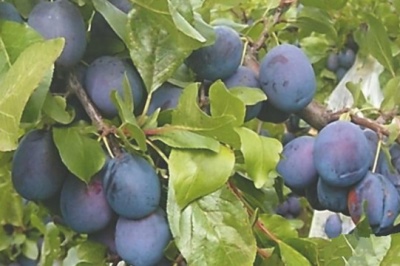
- Authors: Belarus
- Growth type: medium-sized
- Crown: sprawling
- Fruit size: large
- Fruit weight, g: 40
- Fruit shape: standard-extended
- Fruit color: violet-blue
- Skin : with a waxy coating
- Pulp (consistency): dense
- Pulp color : Orange
Plum is one of the most widespread fruit crops in Russia. The Hungarian varietal group is especially widespread. Due to the universal purpose of the fruits, they are often used to prepare desserts, sauces and other delicious treats.
The variety Vengerka Belorusskaya appeared in 2009. This variety is rapidly gaining demand due to a set of positive characteristics. High frost resistance allows you to plant trees in a harsh climate. And also the variety has a strong immune system.
Description of the variety
The plum reaches a height of 5-6 meters. These are medium-sized plants with a spreading crown. Its shape can be pyramidal or oval. To make the harvest more convenient to harvest, the plants are formed with shrubs, maintaining a maximum height of 2-3 meters. Leaves are deep green, elongated. Sizes are medium. Trees begin to bear fruit in the third or second year of life. In comfortable weather conditions, the variety lives up to 25-30 years.
Fruit characteristics
The weight of one fruit is about 40 grams. The sizes are large. Form - standard plum, elongated. The color of ripe berries is bright purple with a blue tint, evenly distributed. The waxy coating is clearly visible on the skin. The consistency of the pulp is firm and firm. Its orange color contrasts with the skin color. A medium-sized bone grows inside. It is easily separated from the pulp when fully ripe. Fruits are suitable for both processing and fresh consumption.
Taste qualities
The taste is pleasant, sweet and sour and refreshing.
Ripening and fruiting
The plum begins to bloom in May, and the harvest is harvested from late August to early autumn. Hungarian Belorusskaya belongs to varieties with an average ripening period.

Yield
The average yield reaches up to 120 tons per hectare of plantation. It is recommended to harvest the fruits in dry weather. The harvesting process is divided into several stages, since the plums do not ripen at the same time.
If the fruits are going to be transported over long distances, they must be removed from the branches a little immature and placed in shallow boxes. In about a week they will reach the technical maturity stage. Remove the fruit along with the stalk. It is advisable to keep the waxy coating on the skin. First, harvest from the lower shoots, gradually moving upward.
Growing and care
The Hungarian Belorusskaya variety loves warmth and sunlight, despite its frost tolerance. For the comfortable development of fruit trees, you need to maintain an optimal moisture level. Plums can be planted near fences or other fences on the sunny side. The main thing is that the garden is protected from strong winds and cold air.
When choosing a site for planting, you need to take into account the future shape of the crown.Considering the height of the trees and the spreading of the crown, you need to leave enough free space for the plant. A slight darkening will not affect the fruiting and palatability of the fruit. The shade can cover the area in the morning and evening.
The variety is watered 5-6 times throughout the season, spending at least 8-10 buckets of water per tree. This frequency of irrigation is necessary for the formation of juicy and tasty fruits. If plants grow near the garden that take up a large amount of moisture, watering should be increased. It is undesirable to use cold and raw water for irrigation. During flowering, ovary formation and fruit ripening, fruit trees especially need moisture and the Hungarian Belorusskaya variety is no exception.
Young plants are irrigated more often than adults. Liquid consumption - 2-3 buckets at a time.
Plants are fertilized according to the scheme.
Urea is introduced first, it is used before the beginning of fruiting. 45 grams of the substance are dissolved in 10 liters.
Nitrophoska will be useful during the period of berry pouring. For 10 liters of water, three tablespoons of this component will suffice.
Once the harvest is harvested, the trees are fed with superphosphate.
At the end of the season, organic is used. Consumption - 10 kilograms of rotted manure per tree.
Pruning is an essential part of plum care. Experienced gardeners advise leaving only large shoots that grow at right angles to the trunk. You should also not forget about sanitary pruning. During work, excess growth is removed. They also get rid of sick, broken and sluggish shoots.
It is advisable to form the crown in the spring. The air temperature must be at least 10 degrees Celsius. The procedure is carried out regularly, from the second year after planting until the end of the plant's life cycle.
By a third, you need to cut the branches of the skeletal row. In the spring, at the beginning of the season, the conductor is pruned. They retreat from the upper shoot by 40 centimeters. After completing the work, you need to try to maintain this shape. The recommended number of skeletal shoots is from 5 to 10 pieces.
The procedure needs to be performed only with sharp and disinfected equipment, and the places with a cut are treated with garden varnish in order to avoid infection.





Despite the fact that plum is considered more hardy than many fruit trees, it is not immune from diseases. It is attacked by viral, fungal and bacterial infections, and parasitic insects harm it. It is necessary to notice and recognize the signs of plum disease in time. They are easier to deal with and defeat early on. Well, in order to protect the garden tree from such a misfortune in the future, preventive procedures can be carried out.



































































